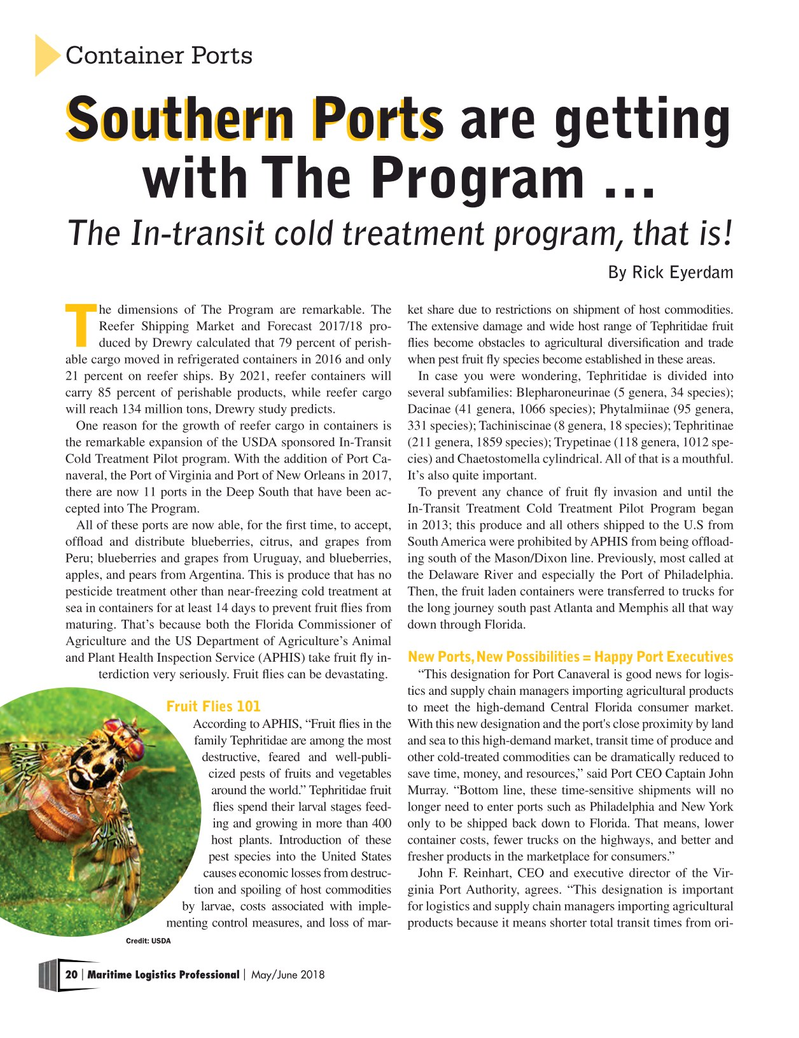
Page 20: of Maritime Logistics Professional Magazine (May/Jun 2018)
Container Ports
Read this page in Pdf, Flash or Html5 edition of May/Jun 2018 Maritime Logistics Professional Magazine
Container Ports
Southern Ports Southern Ports are getting with The Program …
The In-transit cold treatment program, that is!
By Rick Eyerdam he dimensions of The Program are remarkable. The ket share due to restrictions on shipment of host commodities.
Reefer Shipping Market and Forecast 2017/18 pro- The extensive damage and wide host range of Tephritidae fruit
Tduced by Drewry calculated that 79 percent of perish- fies become obstacles to agricultural diversifcation and trade able cargo moved in refrigerated containers in 2016 and only when pest fruit fy species become established in these areas. 21 percent on reefer ships. By 2021, reefer containers will In case you were wondering, Tephritidae is divided into carry 85 percent of perishable products, while reefer cargo several subfamilies: Blepharoneurinae (5 genera, 34 species); will reach 134 million tons, Drewry study predicts. Dacinae (41 genera, 1066 species); Phytalmiinae (95 genera,
One reason for the growth of reefer cargo in containers is 331 species); Tachiniscinae (8 genera, 18 species); Tephritinae the remarkable expansion of the USDA sponsored In-Transit (211 genera, 1859 species); Trypetinae (118 genera, 1012 spe-
Cold Treatment Pilot program. With the addition of Port Ca- cies) and Chaetostomella cylindrical. All of that is a mouthful. naveral, the Port of Virginia and Port of New Orleans in 2017, It’s also quite important.
there are now 11 ports in the Deep South that have been ac- To prevent any chance of fruit fy invasion and until the cepted into The Program. In-Transit Treatment Cold Treatment Pilot Program began
All of these ports are now able, for the frst time, to accept, in 2013; this produce and all others shipped to the U.S from offoad and distribute blueberries, citrus, and grapes from South America were prohibited by APHIS from being offoad-
Peru; blueberries and grapes from Uruguay, and blueberries, ing south of the Mason/Dixon line. Previously, most called at apples, and pears from Argentina. This is produce that has no the Delaware River and especially the Port of Philadelphia. pesticide treatment other than near-freezing cold treatment at Then, the fruit laden containers were transferred to trucks for sea in containers for at least 14 days to prevent fruit fies from the long journey south past Atlanta and Memphis all that way maturing. That’s because both the Florida Commissioner of down through Florida.
Agriculture and the US Department of Agriculture’s Animal and Plant Health Inspection Service (APHIS) take fruit fy in-
New Ports, New Possibilities = Happy Port Executives terdiction very seriously. Fruit fies can be devastating. “This designation for Port Canaveral is good news for logis- tics and supply chain managers importing agricultural products
Fruit Flies 101 to meet the high-demand Central Florida consumer market.
According to APHIS, “Fruit fies in the With this new designation and the port's close proximity by land family Tephritidae are among the most and sea to this high-demand market, transit time of produce and destructive, feared and well-publi- other cold-treated commodities can be dramatically reduced to cized pests of fruits and vegetables save time, money, and resources,” said Port CEO Captain John around the world.” Tephritidae fruit Murray. “Bottom line, these time-sensitive shipments will no fies spend their larval stages feed- longer need to enter ports such as Philadelphia and New York ing and growing in more than 400 only to be shipped back down to Florida. That means, lower host plants. Introduction of these container costs, fewer trucks on the highways, and better and pest species into the United States fresher products in the marketplace for consumers.” causes economic losses from destruc- John F. Reinhart, CEO and executive director of the Vir- tion and spoiling of host commodities ginia Port Authority, agrees. “This designation is important by larvae, costs associated with imple- for logistics and supply chain managers importing agricultural menting control measures, and loss of mar- products because it means shorter total transit times from ori-
Credit: USDA 20 Maritime Logistics Professional May/June 2018 | |

 19
19

 21
21
